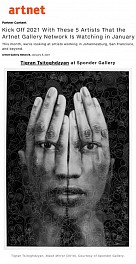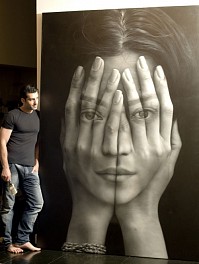Uncanny Portraits: Tigran Tsitoghdzyan's Realism
By Donald Kuspit
What are we to make of Tigran Tsitoghdzyan's "Mirrors" — big, bold portraits, confrontationally large, and black and white, like the negative of a photograph, the colors of life enigmatically erased as though in a melancholy underworld? They are clearly masterpieces, but for all the beauty of the female model peculiarly bleak. However well-realized—empirically precise, insistently descriptive—her appearance, she seems peculiarly unreal. The hands that hide her face, yet let her piercing eyes magically see through them, suggest she is a delusion. Ambiguously transparent and opaque, her hands convey the ambivalence built into the artist's "handling" of her.
The grandeur of Tigran's paintings suggests that she is a delusion of grandeur—that he is deluded about her grandeur, has made her grander and more mysterious than she is in everyday reality. He has mystified her, so that she becomes the mythical eternal feminine, the embodiment of the mystery that is woman, and with that becomes larger than life, a visionary presence yet still a particular person—Tigran's wife, the model who is in fact a professional model, posing for photographers. Tigran begins his portraits with a photograph—today taking the place of the preparatory drawing—and ends with a portrait that however photograph-like has the nuanced touches of a refined painting. Carefully constructed of tonal shadows, it has the emotional subtlety that an everyday photograph lacks. Tigran's portraits lend themselves to reflection, invite lingering contemplation, as a matter-of-fact photograph rarely does. I think this is because each of his portraits, however labor intensive, have the quality of a "primary delusion, i.e., one that arises as an immediate experience, out of the blue, with no external or objective cause or explanation, but nonetheless with a strong feeling of conviction". Out of the blue, in Tigran's portraits out of the black, that is, the haunting female face arises out of the unconscious depths however much it is heightened by consciousness. Tigran's female face is always yonder, at an immense distance, symbolized by its intimidating immensity, however close and impinging it may be. It is a transfixing, perversely sublime spectacle that the spectator only dare view in a mirror–see through a glass darkly, as it were—the way Perseus saw the Medusa's face reflected in the mirror of his shield, so that he would not be petrified by its stare.
Read More >>









